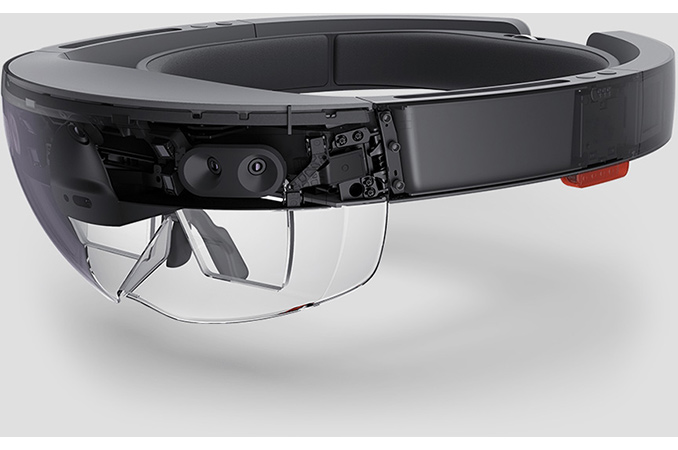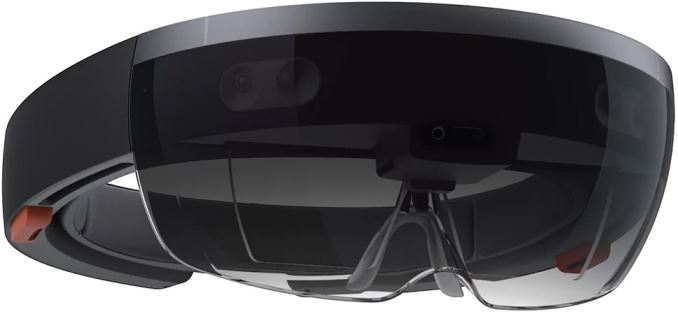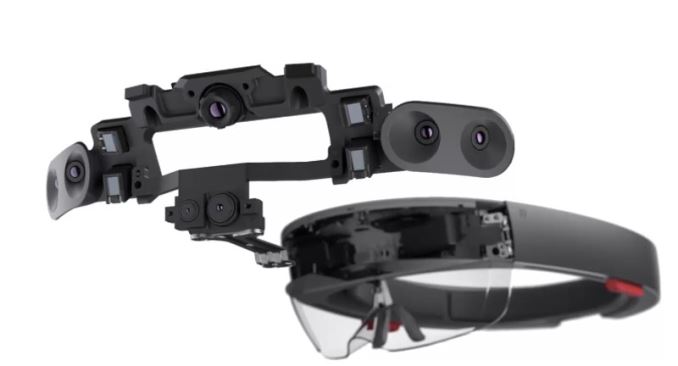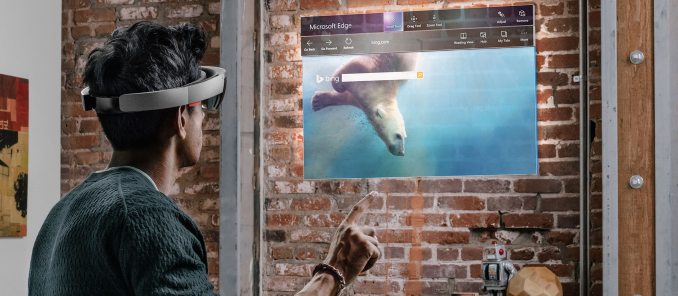Microsoft Reveals Additional Details About HoloLens and Begins to Take Pre-Orders
by Anton Shilov on March 3, 2016 2:00 PM EST- Posted in
- Gadgets
- Microsoft
- Windows 10
- Hololens
- Augemented Reality

Microsoft this week began to accept applications for pre-orders for its HoloLens augmented reality device. Right now, the company offers HoloLens only to software developers looking to build applications for this new environment.Interested developers will have to pay $3000 per unit for this development kit, which is a hefty sum. Moreover, additional technical specifications of HoloLens revealed by Microsoft give us a bit of insight into what is inside this augmented reality wearable.
The Microsoft HoloLens is custom-built wearable personal computer running Windows 10 operating system. The HoloLens is based on an undisclosed 32-bit Intel processor and a custom-designed Microsoft holographic processing unit (HPU) that processes data from multiple sensors. In fact, the list of HoloLens’ sensors is very impressive: the device features one 2 MP video camera, an inertial measurement unit (which means, a set of accelerometers, gyroscopes and maybe even a magnetometer), one depth camera, four environment understanding cameras, four microphones, an ambient light sensor as well as mixed reality capture IC. Since the mixed-reality headset does not use any markers or extra cameras to track movement that are located outside of itself, a sophisticated set of sensors inside it is absolutely required.The HoloLens can track gaze, understand gestures and voice commands thanks to its sensors and underlying software.
The device is equipped with 2 GB of RAM (1GB for the processor and 1GB for the HPU) as well as 64 GB of NAND flash storage. The HoloLens can connect to the Internet or other devices using Wi-Fi 802.11ac and Bluetooth 4.1 LE wireless technologies. In addition, the device is equipped with a Micro-USB 2.0 port, a 3.5 mm audio jack and a surround sound system. The HoloLens can operate for two or three hours on one charge, which is not a lot, but its unlikely you would be wearing this around for a work day. It can also charge while in use, tethering it somewhat but allowing developers to test applications on it as they work.
The AR headset from Microsoft uses its advanced sensors to track the position and orientation of the user's head relative to their surroundings. The system attempts to predict position where the user's head will be in at the exact moment and applies holograms accordingly. Microsoft makes a number of recommendations to software makers how to ensure that the hologram is added to the right place at the right time, but the system constantly monitors not only data from sensors, but also adjusts the length of the rendering pipeline.
The HoloLens uses two see-through holographic lenses (each of which consists of three layers — red, green and blue) with an optical projection system to generate multi-dimensional full-color holograms. Maximum resolution that the HoloLens can render is 1268x720 (per eye), which is why actual holograms have a limited field of view. The holographic content is put at two meters distance from the viewer because Microsoft believes that this is optimal for eyes and will not cause any strain. Since augmented reality is not about maximum resolution, Microsoft puts a lot of focus on quality of each hologram because it is crucial for its usability. According the company, the lenses support holographic density of up to 2.5K radiants (the more radiants and light points there are, the brighter and richer the hologram). But while the quality is very important for AR, to ensure smooth framerate (at least 60 fps) Microsoft suggests to lower resolution of images to 634x360 in certain cases.
Because Microsoft’s HoloLens is a fully-fledged wearable PC, it has its own limitations. The CPU is certainly going to be low powered to allow it to be used mounted on a wearable, possibly Quark or Atom, but Microsoft is not disclosing this yet. Since storage of the wearable PC cannot be upgraded, Microsoft caps maximum allocated size for one application to 900 MB. Finally, the software giant warns that because certain applications may require too much processing power, the system-on-chip of the HoloLens can overheat. To prevent that, HoloLens will shut down the application if temperatures hit certain levels. Consequently, even if a developer managed to create something that uses all the resources of HoloLens, it is not guaranteed that their app will actually work in all circumstances, at least with this developer kit.
So far, Microsoft has developed a limited list of applications for HoloLens to show off capabilities of the AR to developers. The list of productivity apps includes Skype, HoloStudio and Actiongram, whereas the list of entertainment programs includes HoloTour, RoboRaid, Young Conker and Fragments. With only a limited number of programs that support holographic experience, it makes sense that this is a developer kit and not a public release.
Also, the original demos of Hololens used what Microsoft called an "Air Tap" to do selections. This was not that difficult to pick up on, but to make this easier they will be offering a Bluetooth connected hand held device to let you do the clicking with that, rather than having to do the gesture. Since the Hololens supports Windows 10 and Bluetooth, there is likely opportunity here for more peripherals to do other tasks as well.
The Microsoft HoloLens Development Edition will only be available to software developers in the United States and Canada initially. The developers have to participate in the Windows Insider program. To buy the HoloLens, programmers will have to share their ideas regarding their applications with Microsoft. If the software giant likes the idea, its author will get a chance to buy the AR device. The software giant plans to ship the first batch of HoloLenses to chosen developers on March 30, 2016. When additional devices are manufactured, Microsoft will invite more applicants to purchase to the HoloLens. Interested developers may apply for a Microsoft HoloLens device here.
























20 Comments
View All Comments
boeush - Friday, March 4, 2016 - link
I think the Hololens is meant to be highly mobile - meaning, not confined to one room, or even to a house. You're supposed to be able to just walk down the street with it, like you could with Google Glass. Which would exclude any direct (WiFi or Bluetooth) tethering to a PC box.However, I think there might be a compromise in separating the processing from the head gear, and wearing the CPU/GPU/main battery package as a backpack or as a belt. Use an extremely short-range, low-power, secure high-bandwidth wireless setup to communicate between the HMD unit and the main processing box. This would allow much beefier processing, longer battery life, and higher heat dissipation - while maintaining portability, lightening the weight/inertial load on the head and making the HMD unit more streamlined/stylish...
Alexvrb - Friday, March 4, 2016 - link
I'd rather it was either handled all onboard the Lens. The last thing I want is a Lens Backpack or BeltWare (tm). That would just be lame. Heck I wouldn't even really want wires connecting it to my smartphone. Otherwise I agree with what you said, this device is intended to travel.Plus, whatchu talkin' bout Willis? Latency IS an issue. Streaming to a little handheld tabletcontroller with 2D input is nothing like trying to process and stream GOBS of data in two directions in 3D. I mean when you try to use your hands to manipulate 3D virtual objects, it would have to capture and stream to the PC, which crunches what you're doing and sends the results back. That adds some serious latency and would result in a really horrible experience.
Nope, their engineers are on the right path. They'll continue to improve it, too. These are the early days of AR.
willis936 - Saturday, March 5, 2016 - link
By gobs of data you mean literally just the cameras and sensors from the hololens to the computer and the display output from the computer to the hololens? It's not impractical. It's not even that hard as Nintendo demonstrated. Idk why everyone who doesn't make embedded systems for children seem to have a hard time with it.Alexvrb - Saturday, March 5, 2016 - link
Multiple live feeds getting streamed, processed (like Kinect on crack), and then having the resulting visuals and sounds streamed back? In real time? You don't think you're adding delay? Yeah it's not just a question of raw average bandwidth. It's a question of reliability and latency for fairly large streams of data both ways. AR/VR experiences are much more sensitive to latency to begin with than your example.Even the Meta 2 guys (who went external hardware route) opted for wired. But I guess their engineers are actually all morons and you know better than they do.
willis936 - Sunday, March 6, 2016 - link
You know what adds delay? Computing. A 5W power budget isn't going to produce 90 fps even at their suggested 1996 resolution. Saying " it can't be done" is a cheap excuse because it can. Not at unrealistic bit rates but what they're promising with their power budget is unrealistic. Cabled is obviously better because nothing needs to be compressed but those smart designers probably never stopped and asked themselves if people would mind a cable hanging from their face.Alexvrb - Wednesday, March 9, 2016 - link
Man they should hire you because your Wii U controllertablet derived prototype is working so much better than anything their engineers can cook up.Murloc - Saturday, March 5, 2016 - link
how are you going to play pacman on the street or do virtual spear hunting if you're stuck in a room?Friendly0Fire - Saturday, March 5, 2016 - link
The WiiU's display isn't AR. You can't afford the wireless streaming latency, you'll make people sick.willis936 - Saturday, March 5, 2016 - link
Have you played with a wii u? It's sub 10 ms latency and I cannot feel it even when trying. That will make people sick is chugging down to 50 ms frame times because you're trying to play crysis on a toaster.marvdmartian - Monday, March 7, 2016 - link
...and the next Microsoft product to be hacked, and infected with a virus will be.....I sure hope they'll have sense enough not to charge that $3K price tag for people wanting to purchase one of these, when they come out. Of course, seeing the price of the Xbox units they have produced, I won't be very surprised to see a price of half that amount, for this.